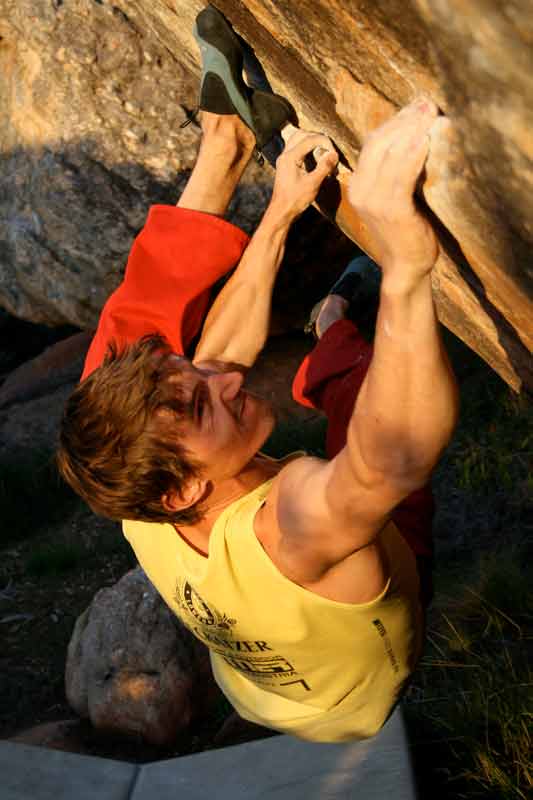Knee pain is common among climbers. In particular, intense knee hooks when bouldering lead to heavy loads on the knee. Klaus Isele, physiotherapist and osteopath, explains to us in today's guest post what the so-called "Hooker's knee" is, what you can do in the case of knee pain and how it differs from other knee pain.
A guest contribution by Klaus Isele - head of the practice Therapierbar
Basically and in general it should be noted at this point that everything I write here reflects my opinion. This is of course shaped by the experience of looking after the Austrian climbing team and the treatment of many other patients who find their way into my practice Therapierbar have found. My measures do not require a scalpel or drama. I rely on osteopathy, physiotherapy, massages or specific training. If none of this helps, then there are still the doctors who take care of the really wild stuff. In a nutshell: This is about conservative measures and what can be done in case of an emergency. In this case: the hooker knee.

Climbers are often affected by knee problems
These then land on me and say: "My knee hurts." My first question: "Where exactly?" And: "How did it all start?" Here are a few of the most common answers:
- And then I tried my project with this heel hook for the umpteenth time when the pain in my knee ...
- On the third semi-final boulder, the one with the hook, I pulled my knee fully over and suddenly it gave me a stab. Since…
- Somehow I had been thinking for two months that I could feel my knee a little. It pulled at the back while jogging and got worse as a result.
- I knuckled my ankle a year ago, after six weeks of tape, everything was fine again, but this knee pain has been there since then and I can always feel it when hooking.
- My friend says that since I felt this pain in my knee three weeks ago, I have been walking with the affected leg completely differently.
Not a typical hook position, but still bad for the knee:
What is the hooker knee?
The pain is usually in the back of the knee, often also in the back of the thigh towards the buttocks. A Hooker's knee is triggered by: Hooking, expressed in more complicated terms by squatting up and "pushing over the knee". So it can be triggered in many positions in which the knee is twisted and at the same time takes on load. Most often it is triggered by maximum rotations, and here more often by external rotation and strong, repeated pulling over a hook (repetitive strain). But also a dynamic pulling on with the upper extremity, with the hook set, and then an unintentional slipping
or not holding the desired target grip leads to symptoms of the hooker knee due to an eccentric force maximization in the knee area.
The biceps femoris muscle is by far the most frequently affected. This muscle supports or guides the external rotation of the lower leg. To my knowledge, he also joins the ranks of the three strongest flexors. And thus fulfills exactly the function that we climbers need for heel hooking. However, depending on how the symptom-causing movement took place, other parts of the lschiocrural muscle group and the popliteus muscle are involved in the symptoms. From the perspective of the joints, special attention should be drawn to the upper ankle joint, and more clearly to the proximal tibiofibular art. Simply put: the knuckle of the fibula on the outside of the knee joint, from which the biceps femoris and thus often the pain comes from. The sentences that have been mentioned above already illustrate some of the consequences:
- Change in gait pattern (often increased external rotation on one side)
- Constantly radiating pain along the leg
- Stretching the affected knee is painful
- Stride length shortens (gentle behavior)
- Pain during rotations / rotations in the knee during exercise. Hooken = Aua
Here one hook follows the other
How do I differentiate this problem from more serious injuries?
It becomes critical with loss of sensitivity when the knee "fails" and buckles. When the pain is too great. If there was a click or a tearing noise during exercise and there is severe swelling or severe pain afterwards. It is not uncommon for movements that also trigger Hooker's knee to injure the meniscus. A surgical procedure is recommended if this injury leads to blockages in the knee joint: Extension or flexion is prevented by a "pinching effect". Parts of the meniscus become trapped when the knee is flexed. This entrapment can often be resolved by a little "shaking and shaking" ... However, if the symptoms recur or do not resolve, a further examination as soon as possible is advisable. A muscle can also be torn off completely or partially. There is severe swelling and pain here. If there is a fracture in the joint area, fine, in this case it is hardly possible to put weight on the leg without severe pain. The next steps are obvious: See a doctor as quickly as possible.
What can I do as an affected athlete?
The idea is not to necessarily get rid of the swelling at any cost, should one be present. Maintaining functionality is the most important thing in the long term! An example: since I hurt my knee three years ago, I've walked a little differently. I also feel a little backache.
That means: It is important to prevent the "damage already done". In my practice, treating gentle or evasive behavior is a much more frequent topic than treating acute injuries. So if you want to save yourself the therapist and many treatments: Try to change your gait pattern as little as possible, even with an existing Hooker's knee. Because of the relieving posture, secondary problems often arise in the sacroiliac joint, and thus also in the lumbar spine area. In the long term, there are gait changes and this leads to an unbalanced muscle length and ability to contract. The gait pattern and the entire function of the associated muscles can change.
What can I do acutely?
In the first acute phase, i.e. no longer than 48 hours after the injury, I recommend the standard procedure according to the PECH rule: break, ice, compression, high camp. For cooling: we are not Americans. You don't have to put your leg on ice for three weeks. I recommend yo-yo cooling: apply an ice pack or other cooling medium, a layer of textile in between and stop and wait as soon as the knee stays cool even when the cooling medium is removed. Do not cool again until you feel warming. Repeat this until the knee does not warm up anymore.
If the leg has to be moved for whatever reason (e.g. a World Cup final), the process should be repeated after the load. A certain swelling is not a negative thing, since it restricts our movement somewhat and protects us from this and from the associated pain from a further expansion of the injury through excessive movement. Subsequently, the way to the therapist is recommended, with a little luck the knee will be a lot better after one or two treatments.
What can I do in the long term?
- Stretch the sciatica (sciocular muscle group)! But with long hold times and several repetitions
- Massage along the painful area
- Be mindful of evasive behavior: Even if it hurts a bit, the step left and right should be the same length.
- If heat is applied, stretching and moving must be performed after the heat is applied.
- Swelling reduction (should this be necessary) through lymphatic drainage and preferably in combination with kinesio tapes
About Klaus Isele

Klaus lsele is a climber, physiotherapist, osteopath, certified trainer for sport climbing and has accompanied the Austrian climbing team for ten years. He also supervised Adam Ondra for two years, whom he helped, among other things, climb the first XNUMXc. Klaus leads the practice Therapierbar with four branches and follows a clear approach: a lot can be treated, you just have to know how.
More about training

+ + +
Credits: Cover picture AO Productions / Adam Ligocki

